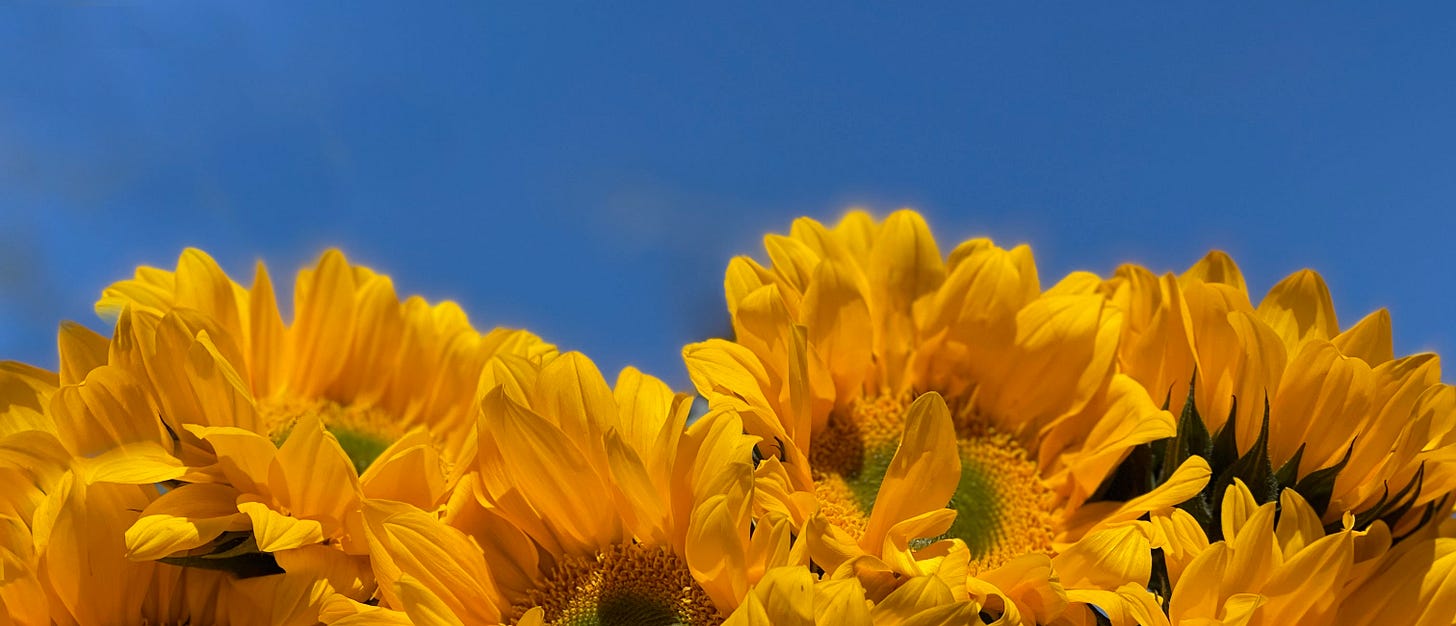Broadening Inclusion
Design to normalize conversations, empower girls, and cultivate women and the environment
I’m a design professor seeking to bridge the academics of environmental sustainability, the professional design community, and those who want to create change but don’t always know where to begin. We know the world around us is not sustainable, instead we need to find ways to design regeneratively - rejuvenating ourselves, our communities, and our planet. This edition reflects on events from Women’s History Month and using an eco-feminist lens in design.
In previous years I used Women’s History month to write about the connections between gender and design (you can read them here or here). This year, I spent the month of March trying to collect my thoughts on eco-feminist design at this moment. But instead, they are tangled in devastating and brave images of war-torn tragedies, the rage of women’s rights repeatedly being taken away (even when admitting to it being “unwise”), the exasperation of the sexist, racist circus on display at the supreme court hearing on Ketanji Brown Jackson, and in discussions of why on earth there’s so much controversy about Turning Red referring to periods. As Women’s History Month came and went, I came to realize that these conversations, while seemingly disconnected, are woven into the underlying issues that have led us to an unjust climate catastrophe.
When I’m asked to define eco-feminism, I usually provide this overly simplified explanation… As a society, we have gendered the planet by calling her “mother nature” and referring to the earth most commonly as she/her. And at the same time, we have normalized a culture where elected officials are proud to “grab 'em by the pussy” and openly engage in sexual violence and assault towards women, where Hollywood glamourizes sexist treatment, and around the world women do not have the same rights and freedoms of men. Because we’ve normalized the violence and oppression of women, and we’ve also gendered the planet as female, the same behavior is being carried over into our exploitation and destruction of the planet leading us to a climate crisis. The desire to dominate over women, and dominate over controlling the earth's resources is the same. The masculine brute force mentality is currently on full display in the violent invasion of Ukraine, the repeated laws being passed in states such as Texas and Idaho that strip women of the rights to their bodies, the harassment of an overqualified well-poised supreme court nominee, and yes, even in the ridiculous made-up controversies of an animated red panda. Oppressing women, oppresses nature. Eco-feminism uplifts and celebrates not only women (and those that identify as female) and our natural environment, but the interactions and connections between them. As I’ve argued before, there is no one quick fix for the climate crisis, it will require a multitude of interconnected systems, actions, and mindsets. Essential to this, in every sector, requires eco-feminist connections to reimage how humans and nature live in community with one another.
We can not design our way out of the climate crisis using the same systems, methods, and mentality that got us into it. The solutions will not come from design for extraction, exploitation, control, and violence. As designers, and as a community we must completely reimagine methods and practices that will shift collective mindsets to live in connection with nature. Eco-feminist theory presents four main factors that have contributed to the climate crisis via the separation of nature and culture: mechanical optimization (that began in the industrial revolution and is present today in Amazon delivery bots), the rise of patriarchal systems that create gendered hierarchies (see examples throughout religious and government organizations), ‘self and other’ dualisms, and the rise of capitalism which exploits the earth for wealth. In short, an eco-feminist mindset designs in connection with, not separate from nature. Inverting the ‘self and other’ dualism, erases the world as binary and creates a broader circle of inclusion. In this, we see that it’s not just about designing for the connection between women and the environment, but also includes racial, ethnic, cultural, and socio-economic class diversities in connection with our just as diverse natural ecosystems. The connection between humans and nature also reflects a return to indigenous practices and acknowledgment that there are in fact more than two genders. Design for maximum regeneration of planetary resources, leadership and organizational change devoid of gendered hierarchies, design for inclusive communities, and anti-capitalism are all much easier said than done. It can be overwhelming to know even where to begin.
To start, it’s not just what we design, but how we design and how we lead design processes. Typically, female leaders have been known to cultivate relationships, model participatory decision making, inspire and reward, which as a result leads to stronger organizational performance. In contrast, we see male-dominated leadership tends to show the desire for control, individual decision-making, and corrective actions. (There are many studies on this, here's just one example.) That desire for singular control can be seen in the invasions, restrictions, roadblocks, and criticism mentioned before. Participatory design processes, and inclusive decision-making that engages stakeholders while cultivating relationships and inspiring engagement is also true of a good design process.
While we absolutely need more women in design leadership, we also need more of everyone to embrace these types of inclusive design and leadership practices. When done truly in connection with community and nature, this shift in the process already begins to invert the status quo operations broadening from single to plural.
In broadening the inclusion of who is designing, we also must position design itself in a broader context. The old school contexts of “graphic design” as typographic posters or shiny logos often display the same desire for exclusive domination and is most commonly connected directly to capitalism via advertising. Design, when uncoupled from simply the graphic, broadens to be more inclusive. Design is not just posters, brochures, websites, and magazines. Design is not just visual. The visual is the artifact from design research and strategy, that causes interactions and experiences, and organizes behaviors and actions. Design is leadership. Design is communication. Design is systems. Design is community.
What then do designers make to create change in the world? From the climate perspective, Project Drawdown tells us that educating women and girls is one of the most impactful things we can do. Throughout Women’s History month, many other environmental organizations and women's rights organizations also called out the connection between supporting women and supporting the planet. Our broadened view of design projects should include design for education systems, advocacy for health care, access to family planning, and ensuring women have the rights to their bodies and their choices. One place to begin this change is exactly in the conversations we have with young people about menstruation and reproductive health. Indeed, these things might not be as “Instagram worthy” or win the “coolest product design awards” but they are the things that will make the most impact, and where we need to have designers working. By this very nature, designers can not work alone. The same broadening inclusion of ideas and workspaces means that designers are working alongside policymakers, activists, scientists, and other change-makers. There’s no one quick fix, instead, we need many solutions, that will plant many seeds, to create the ripple effect of mass change.
Of the many connections that cultures have made between women and nature, the connection between the menstrual cycle and giving birth to the phases of the moon, the rising of tides, and changing of seasons is one of the most prevalent. In recent years, either because of environmental, health, or trendsetting reasons, there has been a rise in the number of reusable period products. Using the power of design and marketing (yes the same thing I said was masculine and capitalistic) companies such as Modibodi, Thinx, flex cups, JUNE, and others have changed the way we see women's bodies. Not only do these products promote “more sustainable solutions” many feature a more diverse representation of people who menstruate. Race, age, body type, stretch marks, and scars, are all more celebrated in the imagery and photography of these ads in comparison to their predecessors. Everyone in these ads is a seed planting an idea to normalize and celebrate the female body. Thinx, for example, chooses to remove gendered words altogether and markets itself as products for “people who have periods”. Additionally, the brand also campaigns to end period poverty, to not only normalize these conversations but also to promote access and inclusion.
And here is where I return to Turning Red and one of the many reasons I’m baffled and angered by the reviews stating it’s not a kids' movie. 50% of the population menstruates, and even if you don’t, you must know about it as menstruation is necessary for us to survive as a species. Getting your period, going through puberty, is not something to hide and keep secret causing shame and embarrassment to young girls. Normalizing conversations about it to include all genders would help everyone. Instead of shame and embarrassment, we’d cultivate strength and courage in our young women, and hopefully respect and understanding from non-menstruating young people. As such we might break the gender hierarchy and duality. Enable the young women with new found strength and courage to become powerful and inclusive leaders who recognize not only the fundamental rights of women to choose what to do with their bodies, but how that is also directly connected to climate change and so many other social issues. If we have more powerful inclusive female leaders perhaps we’d treat them with respect instead of the onslaught that Kentaji Brown Jackson had to take on. And if we cultivate strength and courage, to create powerful, inclusive, respectful leaders, we’d see a true power built on community and inclusion, and connection to the earth that would not require brutal invasions of other countries.
I’ll admit, this is a bit utopic - it might be a stretch to say that if we didn’t shame young girls and hide menstruation from public conversation we wouldn’t have devastating world wars and climate destruction. But we need to start somewhere, with something that has the power to regenerate. We need to move beyond sustainability because our current state is simply not sustainable. The power of regenerative design is to restore, replenish, and renourish. We need a broader inclusion of who is designing, how we are designing, and what we are designing. Not with the attitude to conquer, exploit, and control, but to live in participation with nature, to cultivate, to pollinate, to regenerate the earth.
It’s spring in California and many of the wildflowers in my yard are blooming. Sprouting up, making their way toward the sky are my sunflower sprouts. I’ve seen a lot of sunflowers recently as a symbol of Ukraine and cry for peace. I look at these flowers - their petals reaching outwards, encompassing the bounty of seeds in their center, and see this as a visualization of broadening inclusion. Interestingly, sunflowers are both male and female, their shape both perfect and imperfect. They make excellent companion crops - offering non-hierarchical allyship to other vegetables and flowers nearby. They’ve been planted to remove radioactive toxins from nuclear sites, and on farms to help root systems gain nutrients and water. When their life cycle is complete they leave behind handfuls of new seeds to grow into new plants that will help once again restore the soil, bloom flowers to help the bees, feed the birds their seeds (and people too!) They are a symbol of happiness and peace, and by nature, regenerative design. I encourage you to find ways in which you can plant such seeds through the young people before us.







